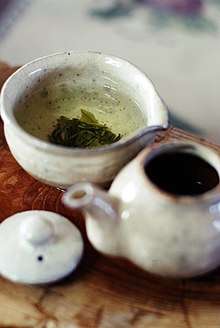Sejak
 Sejak green tea from Hadong County | |
| Type | Nokcha (green tea) |
|---|---|
| Country of origin | Korea |
| Ingredients | Second-flush tea leaves |
| Korean name | |
| Hangul | 세작 |
|---|---|
| Hanja | 細雀 |
| Revised Romanization | sejak |
| McCune–Reischauer | sejak |
| IPA | [se.dʑak̚] |
| Alternative name | |
| Hangul | 두물차 |
| Hanja | --茶 |
| Revised Romanization | dumul-cha |
| McCune–Reischauer | tumul-ch'a |
| IPA | [tu.mul.tɕʰa] |
| Epithet | |
| Hangul | 작설 |
| Hanja | 雀舌 |
| Revised Romanization | jakseol |
| McCune–Reischauer | chaksŏl |
| IPA | [tɕak.s͈ʌl] |
Sejak (세작; 細雀; lit. "thin sparrow"), also called dumul-cha (두물차; lit. "second flush tea"),[1] refers to nokcha (green tea) made of young, tender leaves and buds hand-plucked after gogu ("grain rain", 20–21 April) but before ipha ("advent of summer", 5–6 May).[2][3] Also called jakseol (작설; 雀舌; lit. "sparrow tongue") as the tea leaves are plucked when they are about the size of a sparrow's tongue,[2] sejak is best steeped at a temperature of 60–70 °C (140–158 °F).[4]
References
- ↑ Brother Anthony of Taizé; Kyeong-hee, Hong (2007). The Korean Way of Tea: An Introductory Guide. Seoul: Seoul Selection. p. 13. ISBN 9788991913172.
- 1 2 Richardson, Lisa Boalt (2016) [2014]. Modern Tea: A Fresh Look at an Ancient Beverage 차 상식사전 (in Korean). Translated by 공, 민희. Seoul: Gilbut Publishing. p. 51. ISBN 9791160500370.
- ↑ Jackson, Julie (14 June 2013). "Green as far as the eye can see". The Korea Herald. Retrieved 20 March 2017.
- ↑ Kim, Young-mann, ed. (2004). "Tradition - The Way of Tea: A Lifestyle Aesthetic for Learning the Depth and Enlightenment of Life". Pictorial Korea. Korean Overseas Culture and Information Service. p. 26. OCLC 704162423.
This article is issued from
Wikipedia.
The text is licensed under Creative Commons - Attribution - Sharealike.
Additional terms may apply for the media files.